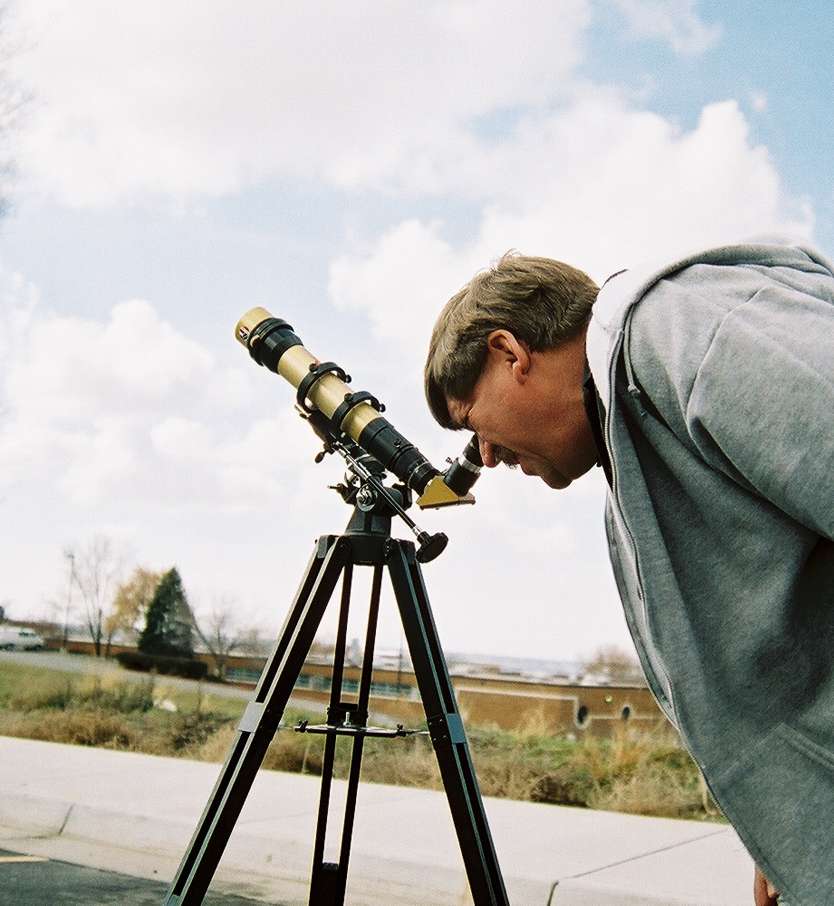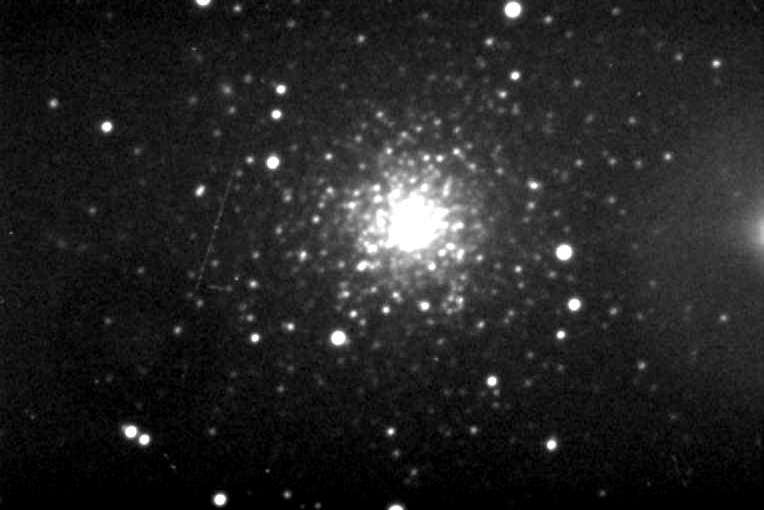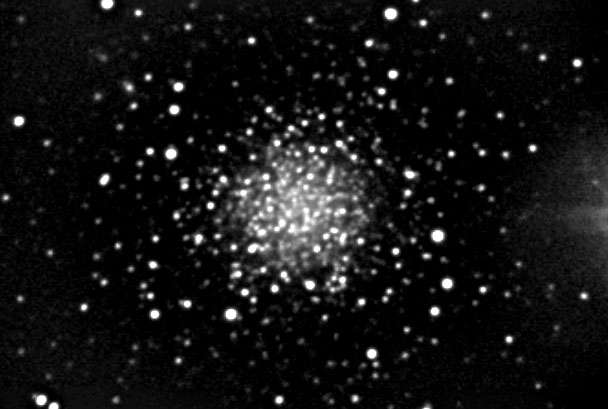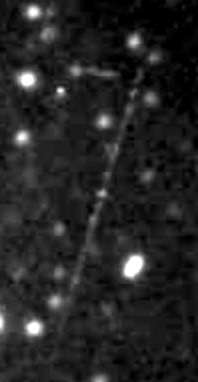

OAS Executive
Committee President- Lee Priest
Ph. (801) 479-5803
Vice Pres- Cliff Peterson
Ph. (801) 782-4378
Secretary- Jim Seargeant
Ph. (801) 479-4050
Treasurer- Doug Say
(801) 731-7324
Vol. 32 Number 6 March 2003 http://physics.weber.edu/oas/oas.html
The President’s Message
Dr. Stacy Palen will be the speaker at the March meeting; her topic is “Looking Over the Galactic Fence---What Our Nearest Neighbors Tell Us About the Fate of the Sun.” The Astronomy Workshop was rescheduled for March 6th, from 7:00 to 8:00 PM in the Ott planetarium. There is a great article on it in the Go section of last Fridays newspaper. I will contact the people that put their names on the list for the green lasers, anyone else interested can contact me. If we have enough people we can order them soon. The equatorial mount for the solar scope is Craig Browne's. Cliff Peterson is making a mounting plate to securely attach the scope to the mount. I tried mounting the solar scope on the finder mount on my LX-90 and that works also. We will discuss the members’ use of the solar scope at the executive committee meeting and it should be available to members soon.
(Doug Say will also do a little show and tell at the March meeting on upgrades he’s made to B.O.B.)
OAS Minutes - 13 Feb 03
President Lee Priest opened the meeting at 7:30.
Announcements/Discussion
Five OAS members have campsites reserved for the Star Party at Dead Horse Point on April 4, 5.
We can put extra people in each and there will be some sites available first come first-serve so
we should have room for everyone that wants to go.
Cliff announced he will be doing a class on "Time Calculations for Astronomy" at the next
Astronomy Workshop to be held on Thursday, February 27 at 7:30 at the Ott Planetarium. Cliff
passed out a handout to get everyone's ideas for topics for future classes. (See date change in
“Astro Workshop,” below.)
Lee set up the new solar scope for everyone to see. He will bring it to the university observatory
this Saturday, 15 Feb, from noon until about 2:00 P.M. for anyone who wants to check it out,
weather permitting. He will try a different day if Saturday is cloudy.
Lee announced the Lowell trip again. Reminder - the OAS has reserved the Lowell Observatory
for the nights of 8 - 10 September 03 for the Mars opposition.
We have a public star party scheduled at the Huntsville branch of the Weber County Library on
March 26.
Lee announced we want to get a set of colored filters for B.O.B. Ron Vanderhule said he thought
we could get a better deal than $80.00, he is going to check into it.
Wayne Sumner has a line on green laser pointers but Ron thought he could get a better deal on
those also.
John Sohl has a few astronomy guides he wants to sell.
For the night’s program, Dr. Brad Carroll gave a very interesting talk on galaxies. He included
the recent results of the WMAP survey that gives the age of the universe as 13.7 billion years,
with a 1% margin of error. Exciting news for the cosmologists among us! (See “WMAP,” below.)
Anticrepuscular Rays Over Horseshoe Canyon
There is a picture of something that was discussed on the list a few weeks ago on APOD. They have a picture of Anticrepuscular Rays over Horseshoe Canyon here in Utah. (Click on the link or see the APOD index - 26 Feb 03.) I know most of you probably look at APOD every day but I thought I would post the link for those that haven't been introduced to these pictures. http://antwrp.gsfc.nasa.gov/apod/astropix.html .
Dave Dunn, from the Utah-astronomy mailing list
Astro Workshop
The workshop on Time Calculations that was scheduled for this Thursday will be moved one week later. It will now be held on March 6 from 7:00 to 8:00 P.M. at the Ott Planetarium on the Weber State University Campus. There will be a Press release for this event coming out soon. This is a free event for anyone interested. Weather permitting there will be a star party after, so bring your telescopes and join us. I hope this change isn't much of an inconvenience for anyone.
Lee Priest
Solar Star Party
 Lee brought the
OAS’s new Coronado Instruments MaxScope40 to WSU’s Observatory parking
lot for an introductory solar star party on 15 Feb. When Ann and I drove up for a quick peek, the
clouds seemed to be playing peek-a-boo with the sun, so quick peeks were all we got. Even so,
the little scope was giving good views of prominences, filaments, and a few small sunspots.
There will be some experimentation to see which eyepieces work best and we speculated a bit
about taking pictures through the MaxScope. My ST7 doesn’t seem to be all that good a match,
but Dale’s STV might be just the ticket, with its small size and ability to take series of images for
a motion picture. (Dale, are you interested?) This little beauty should be a lot of fun at our
summer star parties. (Click on the images for a larger view.)
Lee brought the
OAS’s new Coronado Instruments MaxScope40 to WSU’s Observatory parking
lot for an introductory solar star party on 15 Feb. When Ann and I drove up for a quick peek, the
clouds seemed to be playing peek-a-boo with the sun, so quick peeks were all we got. Even so,
the little scope was giving good views of prominences, filaments, and a few small sunspots.
There will be some experimentation to see which eyepieces work best and we speculated a bit
about taking pictures through the MaxScope. My ST7 doesn’t seem to be all that good a match,
but Dale’s STV might be just the ticket, with its small size and ability to take series of images for
a motion picture. (Dale, are you interested?) This little beauty should be a lot of fun at our
summer star parties. (Click on the images for a larger view.)
Jim Sgt
Coming Events
6 Mar 03, 7:00 P.M. Astronomy Workshop, Ott Planetarium
13 Mar 03, 7:30 P.M. OAS meeting, Ott Planetarium
(Executive meeting at 6:30, meet outside the Ott)
26 Mar 03 Public star party, Huntsville - Weber County Library branch
4, 5 Apr 03 Dead Horse Point star party
WMAP
The Wilkinson Microwave Anisotropy Probe (WMAP) was launched in on June 30, 2001 aboard a Delta II launch vehicle to measure the cosmic microwave background radiation that is the radiant heat left over after the Big Bang. This radiation was first observed by Penzias and Wilson using Bell Labs’ horn antenna in New Jersey, but the level of radiation appeared to be remarkably smooth. NASA’s Cosmic Background Explorer (COBE) satellite first detected tiny fluctuations in this microwave background, but its angular resolution of 7̊ is sensitive only to broad, coarse fluctuations. The WMAP has mapped the fluctuations of the cosmic background radiation with much higher resolution, sensitivity, and accuracy than COBE. These data have allowed several key questions about the nature of the universe to be addressed, including its age of 13.7 billion years. Many internet sites have additional information on the WMAP and its results. Among them are the following:
http://www.to.infn.it/~giunti/NU/exp/all/wmap/
http://www.space.com/scienceastronomy/map_mission_basics_030211.html
http://www.scienceforums.net/forums/showthread.php?threadid=654
And, of course, go to http://www.nasa.gov/ and search on “WMAP”
Jim Sgt
Help!
How ‘bout some help with articles, here? Let’s hear about your projects!
Jim Seargeant’s Images
(Click on the image for a larger view.)

 NGC 2419, the Intergalactic Wanderer, is a 10.4 magnitude globular cluster located just over 7̊
north of Castor. I’ve imaged it before, but with the more sensitive “E” chip installed in my ST-7
camera and with the imaging system set up for f/10, I’ve made it a target as seeing permits. This
is very much a work in progress. This image is the result of combining only five good shots so
far and I normally try for 10 clear ones, plus all of the red, green and blue images. This is going
to be an exercise in persistence - the clears are 20 minutes each at medium resolution. That
means the reds and greens will have to be 40 minutes or more and the blues at least 60 minutes
each. I’m not sure my system will track well enough for that - I’ve never gone over 33 minute
exposures. I’ll have to tune up the polar alignment and periodic error correction for exposures
that long, plus watch for temperature drop that will cause the Meade’s aluminum tube to contract
and shift the focus. Anyone know how to make a carbon fiber tube about 14" in diameter? Let’s
hear it for visual astronomy! Another option will be to take the color shots in low resolution,
which increases sensitivity of the imaging chip. That’s one of the beauties of luminance, red,
green, blue imaging - the clear (luminance) can be at higher resolution because you’re working
with unfiltered - and therefore more - light and the color shots can be made using the imaging
chip’s lower - and more sensitive - resolution.
NGC 2419, the Intergalactic Wanderer, is a 10.4 magnitude globular cluster located just over 7̊
north of Castor. I’ve imaged it before, but with the more sensitive “E” chip installed in my ST-7
camera and with the imaging system set up for f/10, I’ve made it a target as seeing permits. This
is very much a work in progress. This image is the result of combining only five good shots so
far and I normally try for 10 clear ones, plus all of the red, green and blue images. This is going
to be an exercise in persistence - the clears are 20 minutes each at medium resolution. That
means the reds and greens will have to be 40 minutes or more and the blues at least 60 minutes
each. I’m not sure my system will track well enough for that - I’ve never gone over 33 minute
exposures. I’ll have to tune up the polar alignment and periodic error correction for exposures
that long, plus watch for temperature drop that will cause the Meade’s aluminum tube to contract
and shift the focus. Anyone know how to make a carbon fiber tube about 14" in diameter? Let’s
hear it for visual astronomy! Another option will be to take the color shots in low resolution,
which increases sensitivity of the imaging chip. That’s one of the beauties of luminance, red,
green, blue imaging - the clear (luminance) can be at higher resolution because you’re working
with unfiltered - and therefore more - light and the color shots can be made using the imaging
chip’s lower - and more sensitive - resolution.
The seeing was only about 2.7 arcsec on the night of these exposures - 10 Feb. I’d like to get a bunch of shots when the air is really still. I’ve seen sub-2 arcsec seeing from my location when the weather is just right. A nice inversion would do the job. The glow to the right in the image is light pollution from the 7.2 magnitude star SAO 60230.
See the Students for Exploration and Development of Space for a description of this object - http://www.seds.org/messier/xtra/ngc/n2419.html .
See the newsletter posted at the OAS web site (see masthead) for a bit more on this image.

This is one of the raw, unprocessed (but converted to JPEG) shots that went into the image above; its number two in the series of five. Since it’s a raw image with no processing done to sharpen up the stars, it shows just how good (or bad) the tracking was. Even with a 20 minute exposure, the stars are pretty close to round - indicating the AO7 tilt-tip mirror is doing a really good job of tracking. Any imperfection in tracking would give stars that are elongated along the X-axis - left to right in these images. This would be mighty good tracking for a far finer mount than I own. I love my AO7! This is a very satisfactory image for a 20 min exposure, but careful measurement of the star’s profile does show, on average, a slightly larger measurement of FWHM in the X direction compared to the Y, so there is still room for improvement. Part of the enjoyment I have in CCD imaging is in always trying to push the imaging system a little further.
Another interesting point with this image is what appears to be an asteroid or meteor passing by. The streak to the left of center spans about 1.3 arcmin during the 20 min exposure. A satellite would have left a streak all the way through the frame in that time. If it’s a meteor trail, then it must have been quite small and burned up quickly. Meteors we can see visually are large enough to leave a trail all the way across the frame. An asteroid, then? I searched the images taken on either side of this one and could find no trace of it. There is only 2 - 3 minutes between them, so I’d expect to see a trace on either the leading or trailing image if it had been an asteroid. If I’d been on the ball when I took these images I would have seen the trail, taken images along the apparent path, and had several shots of it over time The background stars allow precise position measurement. With several position measurements over time, the Minor Planet Center might be able to identify this object or even register it as a new one. But ... too late. Oh well, probably just a small meteor.